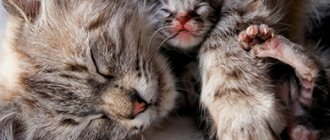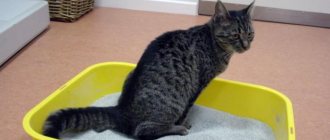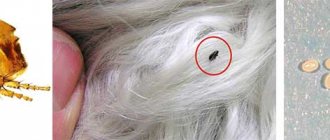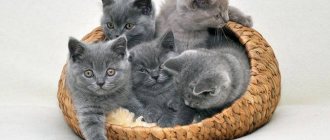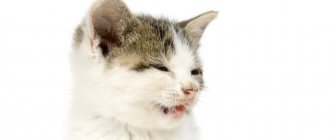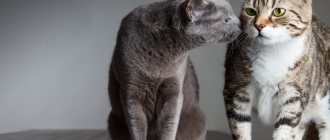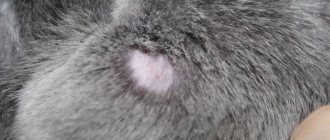Physiological reasons
Physiological factors include natural factors that do not threaten the development of pathologies, for example, pregnancy of an animal. Some of them require the intervention of their owners. The following physiological causes of a large belly in a cat are distinguished:
- pregnancy;
- nervous tension;
- flatulence;
- food poisoning.
Physiological causes of a large belly include pregnancy.
A pet's belly can increase due to muscle tension resulting from pain of any nature, or if the cat itself tenses its muscles, experiencing stress, fearing an attack.
What is fat tail?
The fat tail or primordial pouch is a small fold of skin on a cat's abdomen. It often sags by 3-5 cm. It is most noticeable in short-haired breeds.
When the cat moves, the fold sways from side to side. All cats have this structural feature.
In wild cats it is most pronounced. But in some domestic cats, the fat tail may not be visible to the eye.
Scientists have not yet come to a common conclusion about why cats need a primordial sac. However, they identified several theories explaining the functional purpose of the fat tail.
Protecting internal organs from injury
The stomach is one of the most vulnerable parts of a cat's body. Inside it are vital organs. But the abdomen is not protected by bones, like the sternum or skull. The fold of leather performs a protective function.
When hunting, cats move by hugging the ground. Obviously, the stomach becomes vulnerable to thorns and stones. Also, cats’ stomachs often suffer in fights for territory. Sharp claws easily tear through thin skin, causing serious injuries to the enemy. An additional layer of skin can protect internal organs from bites and cuts.
Nutrient supply
Often the fat tail is most pronounced in well-fed animals. It can also appear and disappear depending on the time of year.
A certain amount of fat accumulates in the skin fold, which is why it sags. And if the animal is starving, first of all the primordial sac decreases in size.
Sometimes predators have to starve for quite a long time. To survive periods of unsuccessful hunts, cats have to accumulate nutrients inside their bodies. The fat tail, in which adipose tissue is stored, is excellent for this purpose. In wild cats, it increases greatly in winter, when the animal eats up before the cold weather, but in summer, during the heat, it decreases.
The fat tail is associated with the movement patterns of cats
Cats' bodies are very flexible. During a hunt, all limbs are literally stretched and tense. When jumping, a cat can bend at a considerable angle. In order for an animal to be able to perform such tricks without hindrance, it needs not only flexible joints, but also elastic skin. Some scientists believe that the fat tail is needed so that the cat can more effectively use the flexibility of its body.
Pathological factors
An enlarged, hard tummy in a cat is observed with the development of a number of serious pathologies. If any abnormalities are detected, you must take your pet to a veterinary clinic. If your pet is thin and has a large belly, you need to monitor him in case he develops symptoms of disease.
We recommend this article:
How to recognize and treat intestinal obstruction in cats
Ascites
This disease is also called abdominal dropsy. Characterized by the accumulation of fluid in the peritoneum. There may be several provoking factors, including disruption of the heart or kidneys. Pathology requires careful diagnosis. Externally, the shape of the abdomen changes when the body position of the four-legged patient changes from saggy to pear-shaped.
Ascites is called abdominal hydrops
Infectious peritonitis
A serious incurable disease caused by coronavirus. Often young individuals are affected. The four-legged patient becomes emaciated, and the abdomen enlarges as fluid accumulates in the peritoneum. The pain syndrome can last for weeks. The disease continues for a month or a year until the animal dies. The main symptom of the disease is bloating.
Pyometra
The pathology affects only cats. The peculiarity of the disease is inflammation and filling of the uterus with pus. If the disease is not diagnosed in time, it continues to progress, and the cat’s abdomen as a whole increases along with the reproductive organ. Treatment involves surgery and complete removal of the uterus. The earlier the disease was identified and eliminated, the greater the chance that the pet will fully recover.
Malignant tumors
If one of the organs of the peritoneum is affected by cancer, then the cat’s abdomen increases along with the growth of the tumor. When palpated, a dense lump is revealed - the tumor itself. In addition to the large tummy, there is asymmetry - one side becomes larger than the other. More often, pathology is detected in older individuals. The lifespan of a pet is difficult to predict.
Obesity
The pathology affects those pets who live in city apartments, lead a sedentary lifestyle and receive poor nutrition, as well as spayed and neutered pets. At the initial stage of development of the disorder, fat is deposited in the groin area and the abdomen sag. If you don't change your cat's lifestyle and diet, obesity will develop. This threatens the pet's death from cardiac obesity.
Table: Determination of the physiological state of the cat
Helminthiasis
All cats are susceptible to infection with worms, even if they do not have access to the street. Helminth infestation is provoked by:
- contaminated food;
- contact with other animals and even insects;
- access to the owner's outdoor shoes.
Even if your pet has regular bowel movements, the peritoneum may be swollen due to the accumulation of parasites inside.
Coprostasis
The pathology is characterized by blockage of the large intestine, due to which there is no bowel movement for several days. Along with the accumulation of feces, the cat's belly grows. Causes of the disease:
- sudden change in food type;
- lack of protein in the diet;
- dehydration;
- binge eating;
- blockage of the intestines with lumps of licked hair;
- defeat by helminths, which accumulate and block the intestinal lumen.
Viral infection
Panleukopenia, or feline distemper, is a dangerous disease that often leads to the death of a pet. Rare pathology. The virus is carried by blood-sucking insects, so even pets that do not have access to the street are not protected from infection.
Peritonitis
Why does the kitten have a big belly, but he himself is thin? One of the most dangerous problems that causes bloating is ascites. In this case, the kitten suffers from the accumulation of fluid in the abdominal cavity. Peritonitis is very dangerous and requires immediate medical intervention.
What to do if a kitten has What to do? It is necessary to determine whether the pet actually has ascites. To do this, it is recommended to pick him up and hold him in an upright position for a while. If the animal’s figure resembles a pear (which occurs as a result of liquid flowing down), and after lowering the kitten’s belly again looks like a ball, then there can be no doubt. Therefore, do not hesitate, go to the doctor.
Signs of pathology
A cat's enlarged belly should be the reason for an unscheduled visit to the veterinarian. Sometimes, if the outflow of urine is disrupted or the intestines are blocked, a timely operation can save the life of a pet.
Why do certain pathologies develop if, in the opinion of the owners, the animal is well cared for? The causes of the development of diseases accompanied by enlargement of the peritoneum are:
- poor nutrition, lack of animal access to water;
- non-compliance with the schedule of vaccination and anthelmintic measures;
- peritoneal injuries;
- development of chronic diseases of internal organs.
There are a number of symptoms, the occurrence of which requires urgent consultation with a veterinarian. These include:
- diarrhea;
- vomit;
- apathy;
- increase in body temperature (hot, dry nose and ears);
- lack of appetite;
- the presence of blood, parasites and their eggs in the stool or urine.
Symptoms indicating illness
In addition to the duration of the bloating, it is important to consider any warning signs. Possible pathology is indicated by:
inflammation, yellowing or blue discoloration of mucous membranes;
too rapid enlargement of the peritoneum or sudden weight loss;
frequent vomiting, diarrhea, or lack of bowel movements for more than 2 days in a row;
lethargy and fever;
pain when emptying the bowel or bladder;
dullness and hair loss;
foam, blood or parasites found in vomit and feces;
increased thirst and loss of appetite;
severe pain in the abdominal area upon palpation.
If a pregnant cat's swollen belly does not return to normal within 1.5 days after birth, call a veterinarian. This condition is typical for unfinished labor. The stuck fetus will have to be removed surgically.
How is diagnosis carried out?
To identify the causes of pathology, a number of diagnostic measures are carried out:
- Lab tests. Examination of feces, urine and blood can reveal infection with parasites and the presence of oncology.
- General inspection. Feeling and listening to the animal's peritoneum helps to correctly identify the cause of the enlargement.
- Ultrasound, radiography. Visualization of the condition of internal organs allows you to accurately determine the disease.
Attempting to diagnose a cat yourself can lead to the death of the pet. The diagnosis is made only after a comprehensive diagnosis. Despite the similarity of symptoms, not all diseases require the same treatment, so seeing a doctor is a must!
General examination Laboratory tests Pet ultrasound
Hard belly treatment
Treatment is not limited to symptom relief; it is aimed primarily at eliminating the disease that caused abdominal hardness. The tactics and scope of treatment measures are determined by the doctor, focusing on the severity of clinical manifestations, the results of laboratory and instrumental examinations. For different diseases, treatment will be radically different.
- According to indications for acute inflammatory processes in the abdominal cavity, intestinal obstruction, blockage of the bile duct, ureter, tumors, surgical treatment is carried out.
- For diseases of the biliary tract, hepatoprotectors, enzymes, choleretic agents, and antispasmodics are prescribed.
- Diseases of the urinary system involve the use of anti-inflammatory, diuretic, antispasmodic drugs, and litholytics.
- For helminthiasis, anthelmintic drugs are used.
- Gynecological problems are solved by prescribing antibiotics, hormones, and drugs that regulate the tone of the uterus.
The decision on the possibility of using traditional medicine in addition to classical methods is made by the attending physician.
Healing from the underlying disease entails getting rid of the symptom of a hard stomach.
For functional disorders that result in an increase in the density of the anterior abdominal wall, it is possible to use certain medications without a doctor’s recommendation. In case of overeating, it is rational to take an enzyme preparation; in case of constipation, a laxative will help; in case of flatulence, sorbents and carminatives are indicated. The neurological causes that determine the symptom are treated with sedative medications.
But, before you do anything on your own, you need to remember that in case of diseases of the abdominal organs and retroperitoneal space, against which the hardness of the abdomen appears, independent incorrect treatment in many cases can lead to aggravation of the situation, the development of complications and death.
Abdominal hardness is an insidious symptom that may be a manifestation of serious problems in the body, the solution of which requires timely consultation with a doctor.
Evdokimova Olga Alexandrovna
Help an animal
Sometimes the owner can provide first aid on his own, but you still need to contact the veterinarian without wasting time.
| Disease | Symptoms | Therapy |
| Coprostasis | Palpation of the abdomen reveals an oblong-shaped compaction | The pet is given an enema and given orally Vaseline oil or a solution of magnesium sulfate |
| Helminthiasis | The appearance of parasites and/or their eggs in stool or vomit | Anti-worm medication with mandatory repeat after 3 weeks |
| Panleukopenia or other virus | Increased body temperature | Diet, antiviral and immunostimulating agents |
| Wet peritonitis | Soft belly | In most cases, the pet is euthanized |
| Ascites | Yellow tint of mucous membranes | Removing fluid from the peritoneum, changing the diet |
Lethargy and drowsiness
Sterilization occurs under general anesthesia, so symptoms such as apathy, lethargy, and drowsiness are normal. Some individuals may remain in this state almost until the moment when it is necessary to remove the sutures. In addition to the fact that she is lethargic, the pet does not eat or drink - it all depends on how the cat’s body is structured. If she is still lethargic, sleeps a lot and does not eat or drink anything after two weeks after the operation, you need to contact a veterinarian.
How the cat behaves after the operation, see further in the video.
Preventive actions
To avoid pathologies accompanied by an enlarged abdomen in a cat, you should adhere to the following rules:
- Provide your pet with proper nutrition. Together with your veterinarian, you can choose a diet that suits the age and health characteristics of the cat. It is important not to overfeed the animal, provide access to clean water, and not feed raw meat or fish.
- Isolate the pet. If your four-legged friend does not have contact with other animals that have access to the street, and with insects that enter through open windows, then the risk of developing infectious diseases and parasites is significantly reduced.
- Use of medications. Even an isolated animal needs to be given dewormers every 3 months and vaccinated according to the cat vaccination schedule.
Proper nutrition is the key to a healthy life for a pet.
If you notice an increase in the size of the cat’s abdomen, you need to monitor your pet to identify additional symptoms and contact a veterinary clinic. It is recommended to palpate and check the animal’s body temperature yourself. Sometimes the owner’s delay can cost the pet’s life.
We recommend this article:
Possible causes, methods of diagnosis and treatment of black feces in cats
Recommended Posts
What to do if your cat has blood in the stool: causes, diagnosis and treatment
A cat scratches its neck: possible causes of itching and methods of treatment
Why castrate a cat: pros and cons of the operation
Possible causes, methods of diagnosis and treatment of black feces in cats
Why does a cat pee with blood and why is it dangerous?
What to do if your Jack Russell Terrier sheds a lot and causes allergies
Refusal of food and water
If the cat does not eat after sterilization, there is no need to worry in the first days. She should not be forced to eat, but after two to three days, refusal to eat is a complication. If the cat is lethargic and does not eat, doctors recommend maintaining the pet’s strength through intravenous nutrition, or you can give liquid broth from a pipette or syringe. It also happens very often after surgery that the animal does not eat its usual foods, since the taste habit changes. For example, after surgery your cat doesn't eat her favorite fish, don't worry.
If, after sterilization, the cat refuses to drink and eat even on the second or third day, you should be wary. A particularly weak animal should generally be left in the clinic, where it will be given full care.
Serious diseases of internal organs
So, the kitten has a big belly. Why does this happen? If your pet is eating properly, but its tummy is still swollen, this may indicate serious illness. It is impossible to determine such a disease by eye. Therefore, pet owners must take their kitten to the veterinarian.
Thus, the cause of bloating can be serious problems with the liver, malignant tumors, improper functioning of the pancreas, as well as abnormalities in the functioning of the immune system. In addition, the kitten may become bloated. But in this case, not only the pet’s stomach will show discomfort. The kitten itself will become fat and gain significant weight.
Of course, this is not the entire list of possible causes of bloating in a kitten. Only an experienced veterinarian with special equipment can see the full picture. So, if the animal has become lethargic and drowsy, you should pay attention to this and immediately consult a doctor.
Flatulence in a pet
Gas in a cat is a common occurrence in veterinary practice.
If she passes a small amount of gas 2-4 hours after eating food, this is part of the digestive process and is considered normal. About 90% of the gases released are methane, which has no odor. But if a pet farts more often than usual, and the passage of gas is accompanied by a terrible “amber” and some other signs, this already indicates that he has flatulence. Flatulence in cats is a process of distension and bloating of the abdomen due to the accumulation of gases and air in the stomach or intestines, which the animal swallows while eating food. The unpleasant odor is the result of the release of hydrogen sulfide and other substances, and the release of the resulting excess through the anus is considered a normal physiological phenomenon inherent in all mammals.
Excessive gas production does not mean that a disease is developing in the cat’s body. It is likely that the four-legged pet simply ate food that was unusual for him, and his intestines did not have time to produce enzymes to digest it.
But if flatulence takes a chronic form, this indicates diseases of the gastrointestinal tract. In addition, accumulated gases put pressure on the diaphragm and make breathing difficult. This can cause shock in your pet and even death.

